Business Case Analysis: EMBA Program Analysis and Factors
VerifiedAdded on 2019/10/30
|6
|1343
|243
Report
AI Summary
This report presents a business case analysis of an Executive MBA (EMBA) program, focusing on key issues arising from a case study. The student identifies three primary challenges: the limited time for team socialization, the geographical diversity of team members, and difficulties in communication and work sharing. Recommendations are provided, emphasizing the effective use of both synchronous and asynchronous communication tools, and the report analyzes project management services, concluding that AceProject is the most suitable option. The report also highlights the importance of virtual meetings and diversity in team-based activities within an educational context, underscoring their benefits for cost-effectiveness, time-saving, and idea generation, while acknowledging the need for effective leadership to manage diverse teams. The analysis emphasizes how proper utilization of recommended virtual communication tools will enable the team to achieve its desired goals.
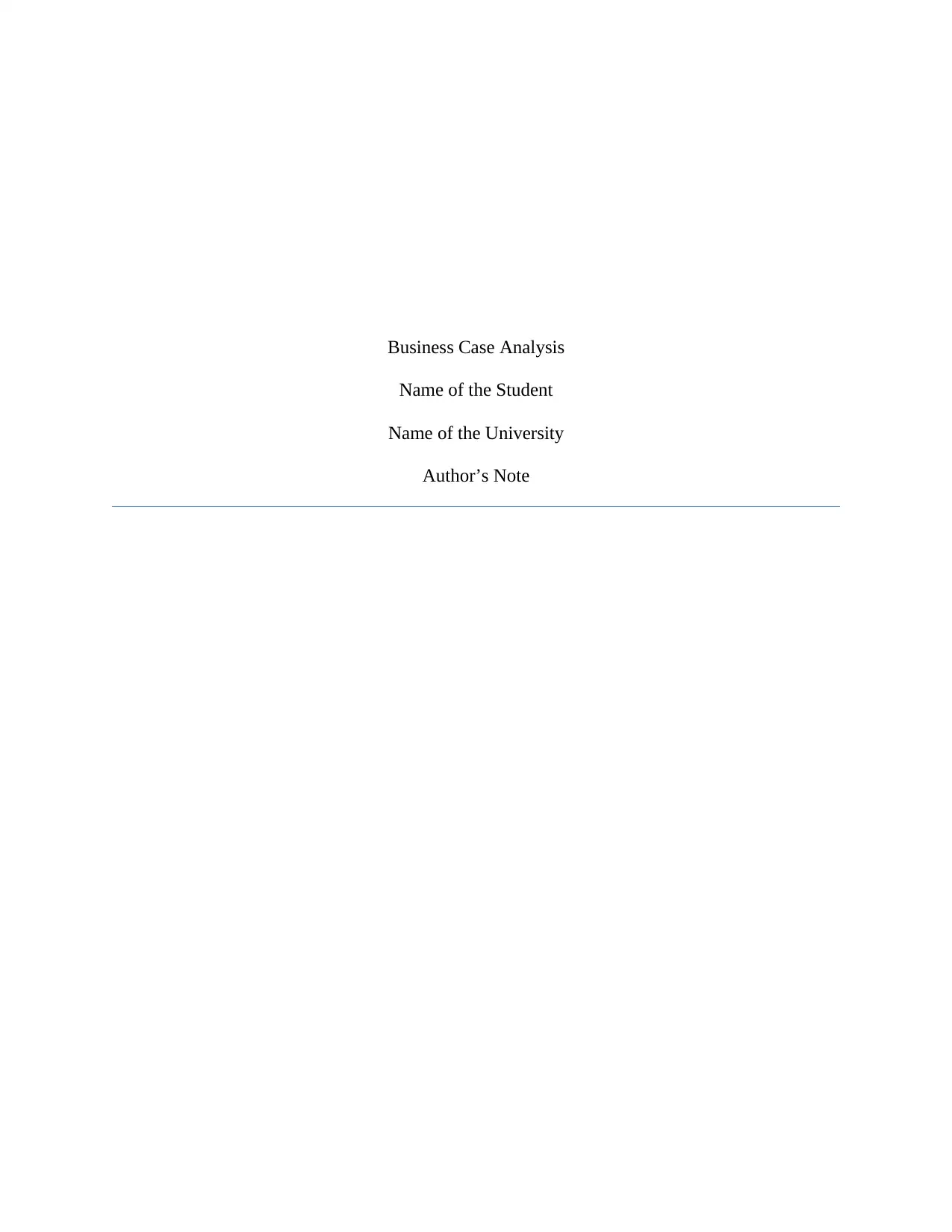
Business Case Analysis
Name of the Student
Name of the University
Author’s Note
Name of the Student
Name of the University
Author’s Note
Paraphrase This Document
Need a fresh take? Get an instant paraphrase of this document with our AI Paraphraser
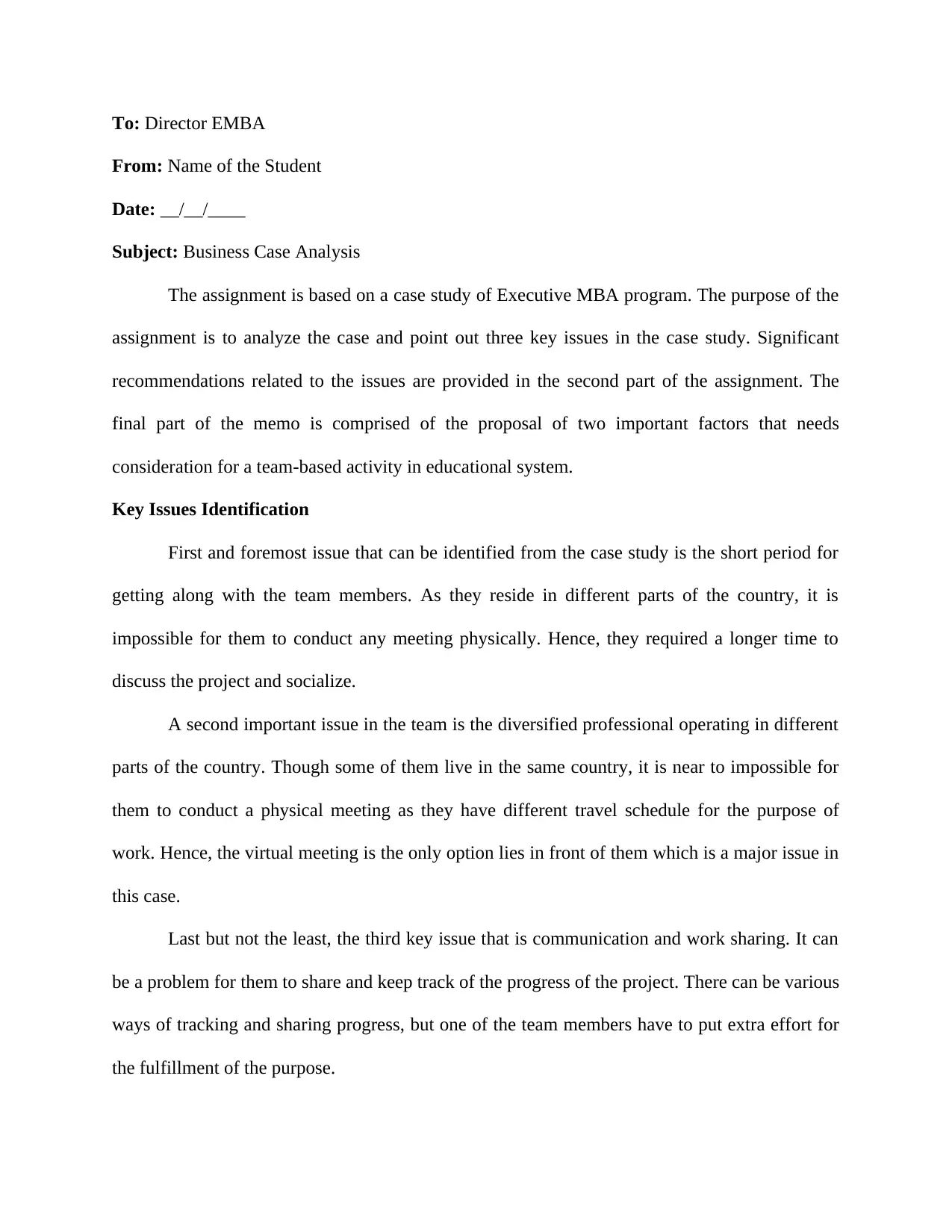
To: Director EMBA
From: Name of the Student
Date: __/__/____
Subject: Business Case Analysis
The assignment is based on a case study of Executive MBA program. The purpose of the
assignment is to analyze the case and point out three key issues in the case study. Significant
recommendations related to the issues are provided in the second part of the assignment. The
final part of the memo is comprised of the proposal of two important factors that needs
consideration for a team-based activity in educational system.
Key Issues Identification
First and foremost issue that can be identified from the case study is the short period for
getting along with the team members. As they reside in different parts of the country, it is
impossible for them to conduct any meeting physically. Hence, they required a longer time to
discuss the project and socialize.
A second important issue in the team is the diversified professional operating in different
parts of the country. Though some of them live in the same country, it is near to impossible for
them to conduct a physical meeting as they have different travel schedule for the purpose of
work. Hence, the virtual meeting is the only option lies in front of them which is a major issue in
this case.
Last but not the least, the third key issue that is communication and work sharing. It can
be a problem for them to share and keep track of the progress of the project. There can be various
ways of tracking and sharing progress, but one of the team members have to put extra effort for
the fulfillment of the purpose.
From: Name of the Student
Date: __/__/____
Subject: Business Case Analysis
The assignment is based on a case study of Executive MBA program. The purpose of the
assignment is to analyze the case and point out three key issues in the case study. Significant
recommendations related to the issues are provided in the second part of the assignment. The
final part of the memo is comprised of the proposal of two important factors that needs
consideration for a team-based activity in educational system.
Key Issues Identification
First and foremost issue that can be identified from the case study is the short period for
getting along with the team members. As they reside in different parts of the country, it is
impossible for them to conduct any meeting physically. Hence, they required a longer time to
discuss the project and socialize.
A second important issue in the team is the diversified professional operating in different
parts of the country. Though some of them live in the same country, it is near to impossible for
them to conduct a physical meeting as they have different travel schedule for the purpose of
work. Hence, the virtual meeting is the only option lies in front of them which is a major issue in
this case.
Last but not the least, the third key issue that is communication and work sharing. It can
be a problem for them to share and keep track of the progress of the project. There can be various
ways of tracking and sharing progress, but one of the team members have to put extra effort for
the fulfillment of the purpose.
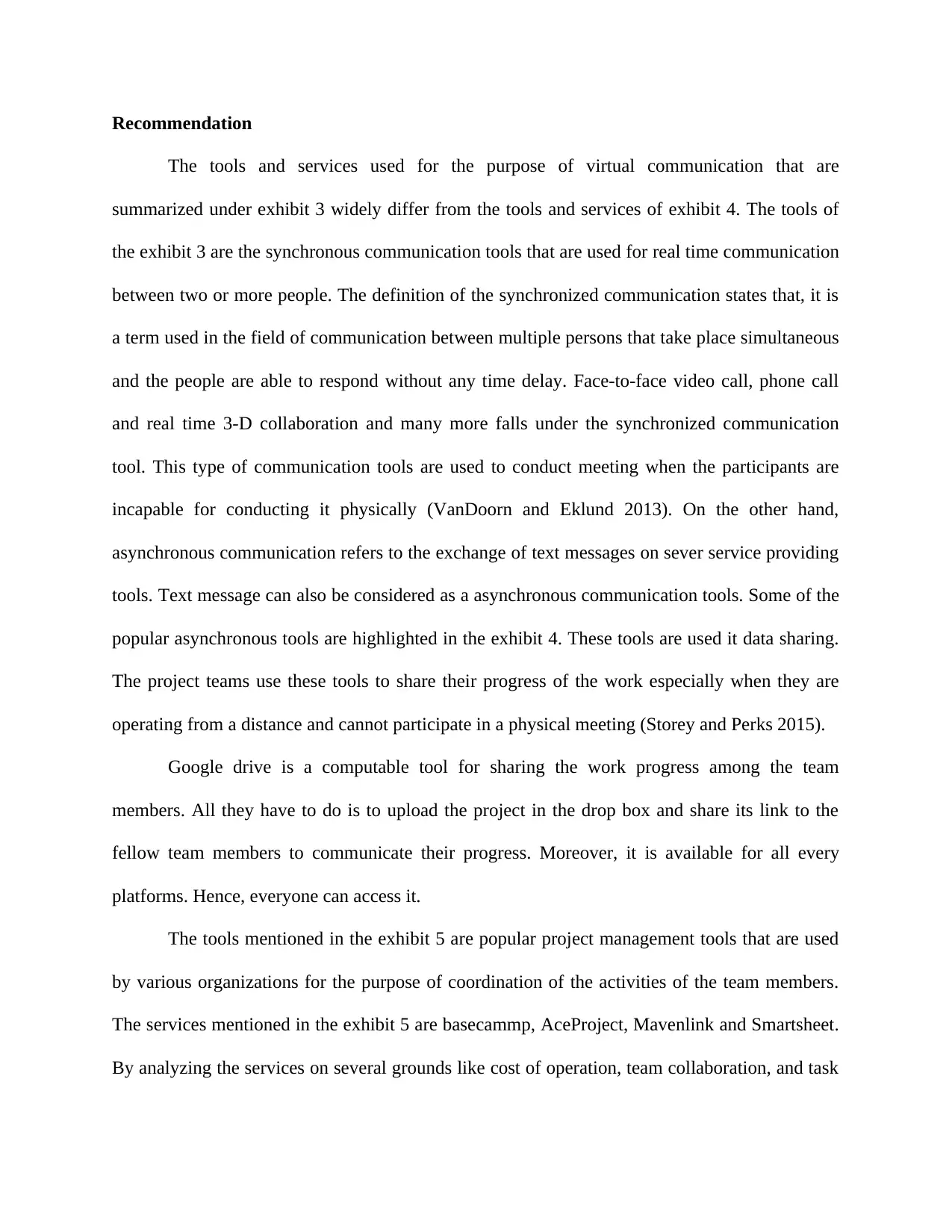
Recommendation
The tools and services used for the purpose of virtual communication that are
summarized under exhibit 3 widely differ from the tools and services of exhibit 4. The tools of
the exhibit 3 are the synchronous communication tools that are used for real time communication
between two or more people. The definition of the synchronized communication states that, it is
a term used in the field of communication between multiple persons that take place simultaneous
and the people are able to respond without any time delay. Face-to-face video call, phone call
and real time 3-D collaboration and many more falls under the synchronized communication
tool. This type of communication tools are used to conduct meeting when the participants are
incapable for conducting it physically (VanDoorn and Eklund 2013). On the other hand,
asynchronous communication refers to the exchange of text messages on sever service providing
tools. Text message can also be considered as a asynchronous communication tools. Some of the
popular asynchronous tools are highlighted in the exhibit 4. These tools are used it data sharing.
The project teams use these tools to share their progress of the work especially when they are
operating from a distance and cannot participate in a physical meeting (Storey and Perks 2015).
Google drive is a computable tool for sharing the work progress among the team
members. All they have to do is to upload the project in the drop box and share its link to the
fellow team members to communicate their progress. Moreover, it is available for all every
platforms. Hence, everyone can access it.
The tools mentioned in the exhibit 5 are popular project management tools that are used
by various organizations for the purpose of coordination of the activities of the team members.
The services mentioned in the exhibit 5 are basecammp, AceProject, Mavenlink and Smartsheet.
By analyzing the services on several grounds like cost of operation, team collaboration, and task
The tools and services used for the purpose of virtual communication that are
summarized under exhibit 3 widely differ from the tools and services of exhibit 4. The tools of
the exhibit 3 are the synchronous communication tools that are used for real time communication
between two or more people. The definition of the synchronized communication states that, it is
a term used in the field of communication between multiple persons that take place simultaneous
and the people are able to respond without any time delay. Face-to-face video call, phone call
and real time 3-D collaboration and many more falls under the synchronized communication
tool. This type of communication tools are used to conduct meeting when the participants are
incapable for conducting it physically (VanDoorn and Eklund 2013). On the other hand,
asynchronous communication refers to the exchange of text messages on sever service providing
tools. Text message can also be considered as a asynchronous communication tools. Some of the
popular asynchronous tools are highlighted in the exhibit 4. These tools are used it data sharing.
The project teams use these tools to share their progress of the work especially when they are
operating from a distance and cannot participate in a physical meeting (Storey and Perks 2015).
Google drive is a computable tool for sharing the work progress among the team
members. All they have to do is to upload the project in the drop box and share its link to the
fellow team members to communicate their progress. Moreover, it is available for all every
platforms. Hence, everyone can access it.
The tools mentioned in the exhibit 5 are popular project management tools that are used
by various organizations for the purpose of coordination of the activities of the team members.
The services mentioned in the exhibit 5 are basecammp, AceProject, Mavenlink and Smartsheet.
By analyzing the services on several grounds like cost of operation, team collaboration, and task
⊘ This is a preview!⊘
Do you want full access?
Subscribe today to unlock all pages.

Trusted by 1+ million students worldwide
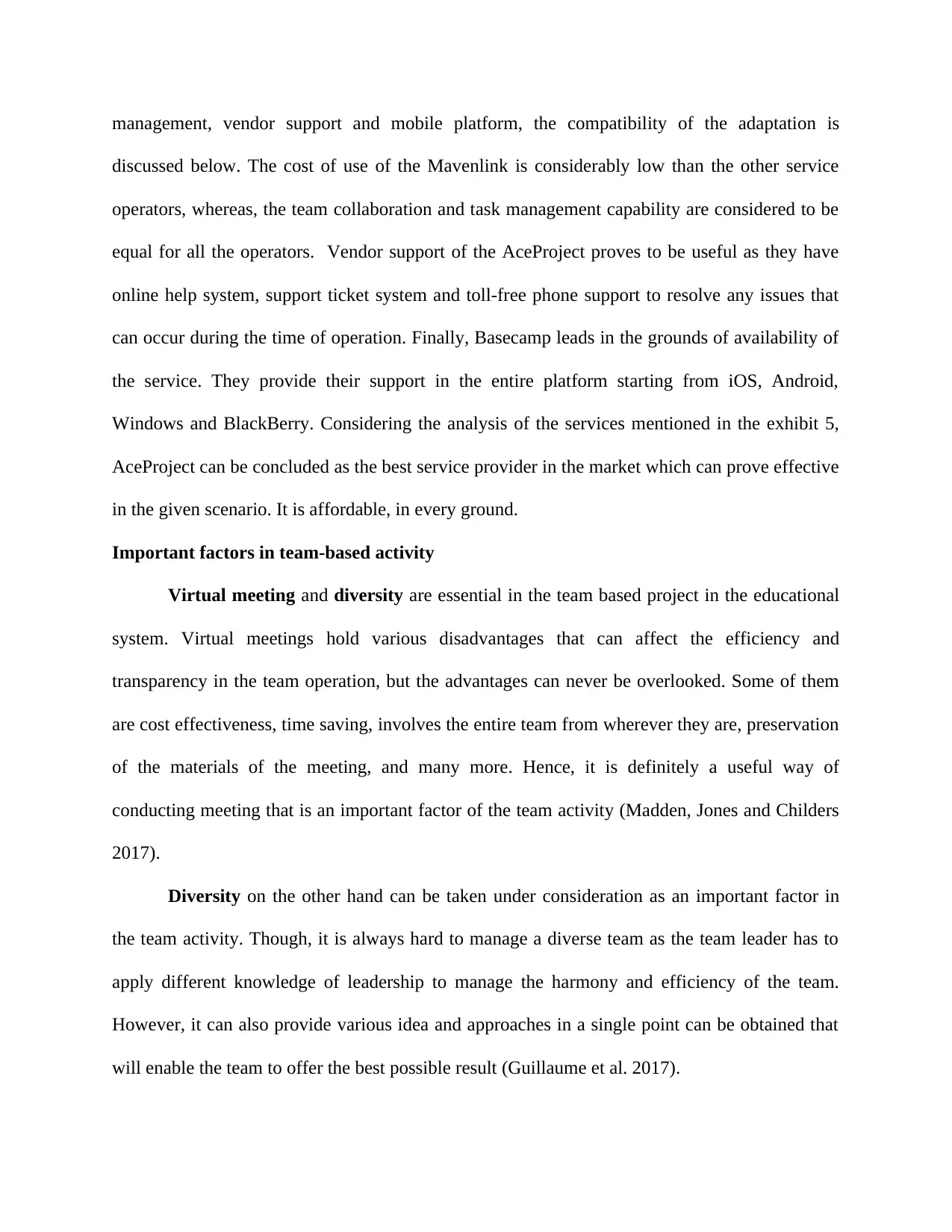
management, vendor support and mobile platform, the compatibility of the adaptation is
discussed below. The cost of use of the Mavenlink is considerably low than the other service
operators, whereas, the team collaboration and task management capability are considered to be
equal for all the operators. Vendor support of the AceProject proves to be useful as they have
online help system, support ticket system and toll-free phone support to resolve any issues that
can occur during the time of operation. Finally, Basecamp leads in the grounds of availability of
the service. They provide their support in the entire platform starting from iOS, Android,
Windows and BlackBerry. Considering the analysis of the services mentioned in the exhibit 5,
AceProject can be concluded as the best service provider in the market which can prove effective
in the given scenario. It is affordable, in every ground.
Important factors in team-based activity
Virtual meeting and diversity are essential in the team based project in the educational
system. Virtual meetings hold various disadvantages that can affect the efficiency and
transparency in the team operation, but the advantages can never be overlooked. Some of them
are cost effectiveness, time saving, involves the entire team from wherever they are, preservation
of the materials of the meeting, and many more. Hence, it is definitely a useful way of
conducting meeting that is an important factor of the team activity (Madden, Jones and Childers
2017).
Diversity on the other hand can be taken under consideration as an important factor in
the team activity. Though, it is always hard to manage a diverse team as the team leader has to
apply different knowledge of leadership to manage the harmony and efficiency of the team.
However, it can also provide various idea and approaches in a single point can be obtained that
will enable the team to offer the best possible result (Guillaume et al. 2017).
discussed below. The cost of use of the Mavenlink is considerably low than the other service
operators, whereas, the team collaboration and task management capability are considered to be
equal for all the operators. Vendor support of the AceProject proves to be useful as they have
online help system, support ticket system and toll-free phone support to resolve any issues that
can occur during the time of operation. Finally, Basecamp leads in the grounds of availability of
the service. They provide their support in the entire platform starting from iOS, Android,
Windows and BlackBerry. Considering the analysis of the services mentioned in the exhibit 5,
AceProject can be concluded as the best service provider in the market which can prove effective
in the given scenario. It is affordable, in every ground.
Important factors in team-based activity
Virtual meeting and diversity are essential in the team based project in the educational
system. Virtual meetings hold various disadvantages that can affect the efficiency and
transparency in the team operation, but the advantages can never be overlooked. Some of them
are cost effectiveness, time saving, involves the entire team from wherever they are, preservation
of the materials of the meeting, and many more. Hence, it is definitely a useful way of
conducting meeting that is an important factor of the team activity (Madden, Jones and Childers
2017).
Diversity on the other hand can be taken under consideration as an important factor in
the team activity. Though, it is always hard to manage a diverse team as the team leader has to
apply different knowledge of leadership to manage the harmony and efficiency of the team.
However, it can also provide various idea and approaches in a single point can be obtained that
will enable the team to offer the best possible result (Guillaume et al. 2017).
Paraphrase This Document
Need a fresh take? Get an instant paraphrase of this document with our AI Paraphraser
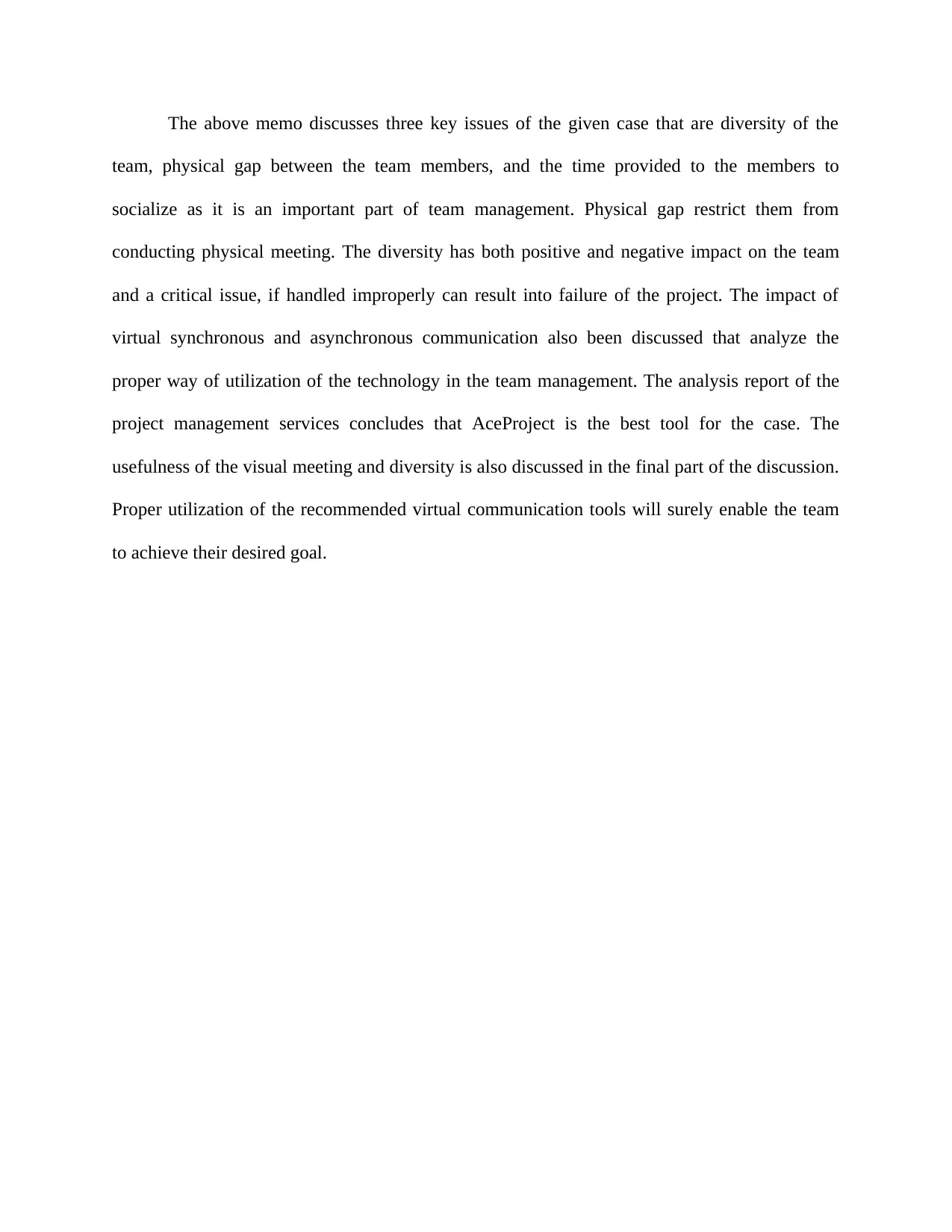
The above memo discusses three key issues of the given case that are diversity of the
team, physical gap between the team members, and the time provided to the members to
socialize as it is an important part of team management. Physical gap restrict them from
conducting physical meeting. The diversity has both positive and negative impact on the team
and a critical issue, if handled improperly can result into failure of the project. The impact of
virtual synchronous and asynchronous communication also been discussed that analyze the
proper way of utilization of the technology in the team management. The analysis report of the
project management services concludes that AceProject is the best tool for the case. The
usefulness of the visual meeting and diversity is also discussed in the final part of the discussion.
Proper utilization of the recommended virtual communication tools will surely enable the team
to achieve their desired goal.
team, physical gap between the team members, and the time provided to the members to
socialize as it is an important part of team management. Physical gap restrict them from
conducting physical meeting. The diversity has both positive and negative impact on the team
and a critical issue, if handled improperly can result into failure of the project. The impact of
virtual synchronous and asynchronous communication also been discussed that analyze the
proper way of utilization of the technology in the team management. The analysis report of the
project management services concludes that AceProject is the best tool for the case. The
usefulness of the visual meeting and diversity is also discussed in the final part of the discussion.
Proper utilization of the recommended virtual communication tools will surely enable the team
to achieve their desired goal.
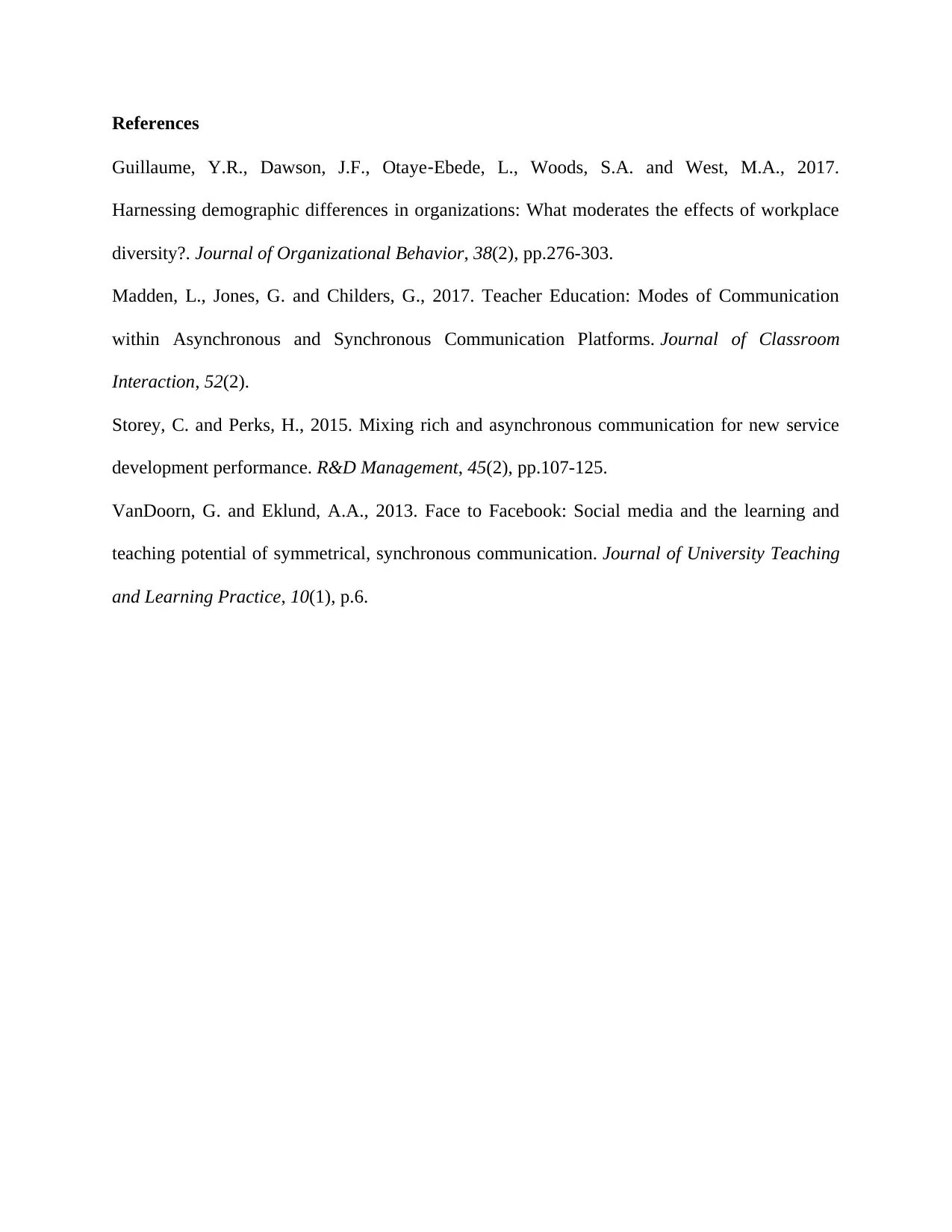
References
Guillaume, Y.R., Dawson, J.F., Otaye‐Ebede, L., Woods, S.A. and West, M.A., 2017.
Harnessing demographic differences in organizations: What moderates the effects of workplace
diversity?. Journal of Organizational Behavior, 38(2), pp.276-303.
Madden, L., Jones, G. and Childers, G., 2017. Teacher Education: Modes of Communication
within Asynchronous and Synchronous Communication Platforms. Journal of Classroom
Interaction, 52(2).
Storey, C. and Perks, H., 2015. Mixing rich and asynchronous communication for new service
development performance. R&D Management, 45(2), pp.107-125.
VanDoorn, G. and Eklund, A.A., 2013. Face to Facebook: Social media and the learning and
teaching potential of symmetrical, synchronous communication. Journal of University Teaching
and Learning Practice, 10(1), p.6.
Guillaume, Y.R., Dawson, J.F., Otaye‐Ebede, L., Woods, S.A. and West, M.A., 2017.
Harnessing demographic differences in organizations: What moderates the effects of workplace
diversity?. Journal of Organizational Behavior, 38(2), pp.276-303.
Madden, L., Jones, G. and Childers, G., 2017. Teacher Education: Modes of Communication
within Asynchronous and Synchronous Communication Platforms. Journal of Classroom
Interaction, 52(2).
Storey, C. and Perks, H., 2015. Mixing rich and asynchronous communication for new service
development performance. R&D Management, 45(2), pp.107-125.
VanDoorn, G. and Eklund, A.A., 2013. Face to Facebook: Social media and the learning and
teaching potential of symmetrical, synchronous communication. Journal of University Teaching
and Learning Practice, 10(1), p.6.
⊘ This is a preview!⊘
Do you want full access?
Subscribe today to unlock all pages.

Trusted by 1+ million students worldwide
1 out of 6
Related Documents
Your All-in-One AI-Powered Toolkit for Academic Success.
+13062052269
info@desklib.com
Available 24*7 on WhatsApp / Email
![[object Object]](/_next/static/media/star-bottom.7253800d.svg)
Unlock your academic potential
Copyright © 2020–2025 A2Z Services. All Rights Reserved. Developed and managed by ZUCOL.





